

TOUCH AND FEEL: FINS' ROLE IN NAVIGATION. Stubbing your toe on a table leg is not an enjoyable experience.

Although we can all be clumsy at times, for most of us this is not a frequent occurrence as we're usually pretty good at navigating our way through complex environments. However, we're not the only ones living in cluttered environments; fish also face obstacles in their habitats, be it a coral reef or a reedy lake bottom. So, how do they manoeuvre their way around these hurdles?
It's a question that interested Brooke Flammang, a post-doc in George Lauder's group at Harvard University, USA: ‘Up until now, the majority of studies of fish swimming have looked at them just swimming in a completely open environment in a tank without anything around them, to just really understand the fish itself. To begin, Flammang created an obstacle course by placing several posts in a flow tank – essentially a treadmill for fish – taking care that there was a route that the fish could take without ever having to bump into the posts.
A Farm That Extends Deep Into The Sea Is Trying To Create Ocean Vegetarianism. Humans should eat the entire water column, says Bren Smith, a commercial fisherman in New York.
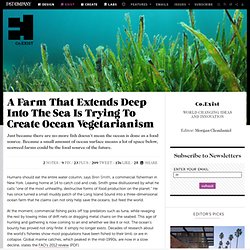
Leaving home at 14 to catch cod and crab, Smith grew disillusioned by what he calls "one of the most unhealthy, destructive forms of food production on the planet. " He has since turned a small muddy patch of the Long Island Sound into a three-dimensional ocean farm that he claims can not only help save the oceans, but feed the world. At the moment, commercial fishing picks off top predators such as tuna, while ravaging the rest by towing miles of drift nets or dragging metal chains on the seabed.
This age of hunting and gathering is now coming to an end whether we like it or not. The ocean’s bounty has proved not only finite: it simply no longer exists. Salmon steak from GM fish could soon be on your plate. 22 January 2013Last updated at 19:15 ET By Katia Moskvitch Technology reporter, BBC News Comparison of GM salmon and a non-GM salmon (foreground) of the same age Biologists believe they are on the cusp of producing the first genetically modified fish fit for human consumption.
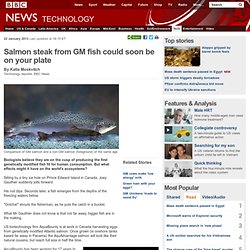
But what effects might it have on the world's ecosystems? Sitting by a tiny ice hole on Prince Edward Island in Canada, Joey Gauthier suddenly jolts forward. His rod dips. "Gotcha! " What Mr Gauthier does not know is that not far away, bigger fish are in the making. US biotechnology firm AquaBounty is at work in Canada harvesting eggs from genetically modified Atlantic salmon. Continue reading the main story Scientists inserted a gene into cats that helps them resist the feline form of Aids They also inserted a gene that produces a fluorescent protein called GFP This protein - which is produced naturally in jellyfish - is commonly used in this area of research to monitor the activity of altered genes Glowing fish. Carbon release from seagrass.
Impact of fisheries on boom and bust cycles. Marine invasives. Oceans as a source of medicines. Acidity. Automated oceanic monitoring. Sea level rise. Marine plastic. Certification and labelling. Disease transmission. Loggerheads Finally Get Promised Protections, but that is only half of the story… Marine Life Published on April 9th, 2013 | by Guest Contributor Sea turtles have been swimming the planet’s waters for millions of years, surviving everything from the mass dinosaur extinction to countless natural disasters and cunning predators.
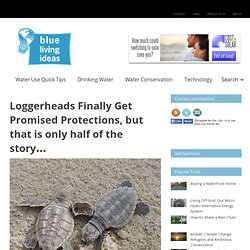
In recent years however, sea turtle populations have begun to plummet as they’ve encountered the one threat they have no defenses against—us. Recently, however, there has been reason for sea turtle lovers to rejoice, as the U.S. Fish and Wildlife Service finally designated 740 miles of critical habitat for threatened loggerhead sea turtles along the East Coast and Gulf of Mexico shorelines. Although this designation is great news, it should have happened years ago. Since their threatened listing in 1978, just five years after the Endangered Species Act was created, critical habitat has never been designated.
Stay tuned to learn more about how you can encourage the U.S. Photo Loggerhead sea turtle hatchling / USFWS About the Author. Natural Barriers Are What Prevent Coastal Cities From Being Destroyed. Before industrial pollution began mucking up our waterways, New York City used to be surrounded by hundreds of millions of oysters clinging to peripheral reefs.

The Florida Keys, meanwhile, had a wealth of coral--until it declined by 44% in the late ‘90s. East of New Orleans, canal dredging and construction destroyed tens of thousands of acres of swampy wetlands that served as buffers against flooding and severe weather. All of these once constituted “soft habitats” that protected our coastlines, but until now, it had been difficult to measure how much work they actually did--and continue to do in the face of climate change. Researchers at Stanford University’s Natural Capital Project have indexed the entire American coastline, kilometer by kilometer, and measured risk of coastal flooding and destruction with and without these habitats. “I didn’t imagine it would be such a large difference,” lead author Katie Arkema said. Arkema and her colleagues didn’t stop there. Study Shows Restored Oyster Reef Worth Its Weight In Nutrients.
Rates of nutrient removal among the highest ever recorded A study led by researcher Lisa Kellogg of the Virginia Institute of Marine Science shows that a restored oyster reef can remove up to 10 times more nitrogen from Chesapeake Bay waters than an unrestored area nearby, providing additional evidence that reef restoration can contribute to efforts to improve water quality in the nation’s largest estuary.
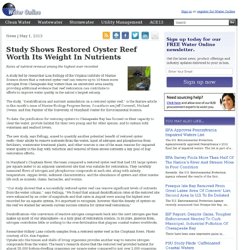
The study, “Denitrification and nutrient assimilation on a restored oyster reef,” is the feature article in this month’s issue of Marine Ecology Progress Series. Co-authors are Jeff Cornwell, Michael Owens, and Ken Paynter of the University of Maryland Center for Environmental Science. To date, the justification for restoring oysters to Chesapeake Bay has focused on their capacity to clear the water, provide habitat for their own young and for other species, and to sustain both watermen and seafood lovers. Global Environmental Change - Can marine fisheries and aquaculture meet fish demand from a growing human population in a changing climate?
A Plymouth Marine Laboratory, Prospect Place, The Hoe, Plymouth, PL1 3DH, UK b Animal & Plant Sciences, University of Sheffield, Alfred Denny Building, Western Bank, Sheffield, S10 2TN, UK c Proudman Oceanographic Laboratory, 6 Brownlow Street, Liverpool L3 5DA, UK d The WorldFish Center, GPO Box 500, Penang, Malaysia e Simon Fraser University, 8888 University Drive, Burnaby, BC V5A 1S6, Canada f School of Environmental Sciences, University of East Anglia, Norwich NR7, 4TJ, UK g Centre for Environment, Fisheries and Aquaculture Science, Lowestoft, Suffolk NR33, 0HT, UK h Unité de Recherche Ecosystèmes Marins Exploités, Avenue Jean Monnet, 34200, Séte, France i School of Marine Science and Engineering, University of Plymouth, Drake Circus, Plymouth PL4 8AA, UK Corresponding author.
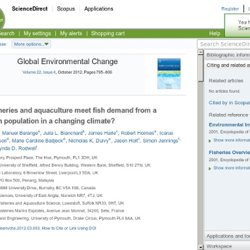
Tel.: +44 0 1752 633476; fax: +44 0 1752 633101. Received 21 June 2011 Revised 9 March 2012 Accepted 14 March 2012 Available online 15 April 2012. Operation Deep Sleep: or, dormant robots at the bottom of the sea. [Image: An otherwise unrelated photo of lift bags being used in underwater archaeology; via NOAA].
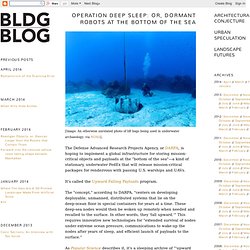
The Defense Advanced Research Projects Agency, or DARPA, is hoping to implement a global infrastructure for storing mission-critical objects and payloads at the "bottom of the sea"—a kind of stationary, underwater FedEx that will release mission-critical packages for rendezvous with passing U.S. warships and UAVs. It's called the Upward Falling Payloads program.
The "concept," according to DARPA, "centers on developing deployable, unmanned, distributed systems that lie on the deep-ocean floor in special containers for years at a time. These deep-sea nodes would then be woken up remotely when needed and recalled to the surface. Bottom trawling resuspends sediment and relea... [Environ Pollut.